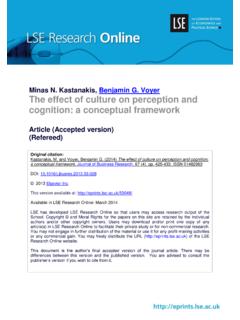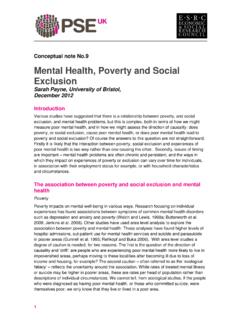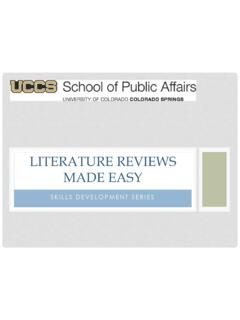Transcription of Conceptual Framework - SAGE Publications
1 39 Biologist Bernd Heinrich (1984, pp. 141 151) and his associates once spent a summer conducting detailed, systematic research on ant lions, small insects that trap ants in pits they have dug. Returning to the university in the fall, Heinrich was surprised to dis-cover that his results were quite different from those published by other researchers. Redoing his experiments the following summer to try to understand these discrepan-cies, Heinrich found that he and his fellow researchers had been led astray by an unex-amined assumption they had made about the ant lions time frame: Their observations hadn t been long enough to detect some key aspects of these insects behavior. As he concluded, Even carefully collected results can be misleading if the underlying context of assumptions is wrong (p.)
2 151).For this reason, the Conceptual Framework of your study the system of concepts, assumptions, expectations, beliefs, and theories that supports and informs your research is a key part of your design (Miles & Huberman, 1994; Robson, 2011). Miles and Huberman (1994) defined a Conceptual Framework as a visual or written product, one that explains, either graphically or in narrative form, the main things to be stud-ied the key factors, concepts, or variables and the presumed relationships among them (p. 18).1 Here, I use the term in a broader sense, to refer to the actual ideas and beliefs that you hold about the phenomena studied, whether these are written down or not; this may also be called the theoretical Framework or idea context for the study.
3 A valuable guide to developing a Conceptual Framework and using this throughout the research process, with detailed analyses of four actual studies, is Ravitch and Riggan, Reason & Rigor: How Conceptual Frameworks Guide Research (2011). (Full disclosure: Sharon Ravitch is a former student of mine, and I wrote the foreword for the book.)The most important thing to understand about your Conceptual Framework is that it is primarily a conception or model of what is out there that you plan to study, and of what is going on with these things and why a tentative theory of the phenomena that you are investigating. The function of this theory is to inform the rest of your design to help you to assess and refine your goals, develop realistic and relevant research questions, select appropriate methods, and identify potential validity threats to your 3 Conceptual FrameworkWhat Do You Think Is Going On?
4 40 QualITaTIve ReseaRch DesIGnconclusions. It also helps you justify your research, something I discuss in more detail in Chapter 7. In this chapter, I discuss the different sources for this theory, and how to use theory effectively in your design. I describe the nature of theory in more detail later in the chapter, in dealing with the uses of existing theory. Here, I want to emphasize that your Conceptual Framework is a theory, however tentative or incomplete it may is often called the research problem is a part of your Conceptual Framework , and formulating the research problem is often seen as a key task in designing your study. It is part of your Conceptual Framework (although it is often treated as a separate component of a research design or proposal) because it identifies something that is going on in the world, something that is itself problematic or that has consequences that are problematic.
5 Your research problem functions (in combination with your goals) to justify your study, to show people why your research is important. In addition, this problem is presumably something that is not fully understood, or that we don t ade-quately know how to deal with; therefore, we want more information about it. Not every study will have an explicit statement of a research problem, but every good research design contains an implicit or explicit identification of some issue or problem, intellectual or practical, about which more information is needed. (The justification of needed is where your goals come into play.)Many writers identify the part of a research design, proposal, or published paper that deals with the Conceptual Framework of a study as the literature review.
6 This can be a dangerously misleading term. In developing your Conceptual Framework , you should not simply review and summarize some body of theoretical or empirical Publications , for three reasons: 1. It can lead to a narrow focus on the literature, ignoring other Conceptual resources that may be of equal or greater importance for your study. As Locke, Spirduso, and Silverman (1993) pointed out, In any active area of inquiry the current knowledge base is not in the library it is in the invisible college of informal associations among research workers (p. 48). This knowledge can be found in unpublished papers, dissertations in progress, and grant applications, as well as in the heads of researchers working in this field.
7 Locke, Spirduso, and Silverman emphasized that The best introduction to the current status of a research area is close association with advisors who know the territory (p. 49). In addition, an exclusive orientation toward the literature leads you to ignore your own experience, your speculative thinking (discussed later in the section titled Thought Experiments ), and any pilot and exploratory research that you ve done. 2. It tends to generate a strategy of covering the field rather than focusing specifically on those studies and theories that are particularly relevant to your research (for more on this, see Maxwell, 2006). Literature reviews that lose sight of this need for relevance often degenerate into a series of book reports on the literature, with no clear connecting thread or argument.
8 The relevant studies may be only a small part of the research in a defined field, and may range across a number of different approaches and The most productive Conceptual frameworks are often those that bring in ideas from outside the traditionally defined field of your study, or that integrate different approaches, lines of investigation, or theories that no one had previously connected. Bernd Heinrich used Adam Smith s The Wealth of Nations in developing a theory of bumblebee foraging and energy chapTeR 3 Conceptual Framework 41balance that emphasized individual initiative, competition, and a spontaneous division of labor, rather than genetic determination or centralized control (Heinrich, 1979, pp.)
9 144 146; 1984, p. 79). 3. It can lead you to think that your task is simply descriptive to report what previous researchers have found or what theories have been proposed. In constructing a Conceptual Framework , your purpose is not only descriptive, but also critical; you need to understand (and clearly communicate in your proposal or research paper) what problems there have been with previous research and theory, what contradictions or holes you have found in existing views, and how your study can make an original contribution to our understanding. You need to treat the literature not as an authority to be deferred to, but as a useful but fallible source of ideas about what s going on, and to attempt to see alternative ways of framing the issues.
10 For good examples of this attitude, see Example and the Context section of Martha Regan-Smith s proposal (Appendix A).Another way of putting this is that a Conceptual Framework for your research is something that is constructed, not found. It incorporates pieces that are borrowed from elsewhere, but the structure, the overall coherence, is something that you build, not something that exists ready-made. It is important for you to pay attention to the existing theories and research that are relevant to what you plan to study, because these are often key sources for understanding what is going on with these phenomena. However, these theories and results are often partial, misleading, or simply wrong. Bernd Heinrich (1984) found that many of the ideas about ant lions in the literature were incorrect, and his subsequent research led to a much more comprehensive and well-supported theory of their behavior.

















